Philips PUS8959, also known by other designations under the PUS89 abbreviation (depending on the sales network), is a model from the popular series The One. Its biggest distinguishing feature is the Ambilight system, which still makes a great impression. The three-sided backlighting adapts to the picture on the screen, making movies, series, or games literally extend beyond the edges of the TV. The One is also a good option for gamers. The 120 Hz panel and low input lag ensure that games run smoothly, and the motion on the screen is clear. On the console, we tested several dynamic titles, and the TV handled them without any problems – no stutters or delays. Additionally, HGiG support allows for better reproduction of HDR effects in games. This is a great solution if we care about the image matching what the creators intended. The picture quality is at a good level, especially during the day. With a brightness of 550 nits, The One performs well even in well-lit rooms, and Dolby Vision in HDR films delivers vivid colors and sharp details. However, the ADS panel has its limitations – the blacks in dark scenes resemble a gray shade more, which can be noticeable when watching in a dimly lit room. When we watched movies with the lights off, the lack of depth in the blacks was somewhat evident. The Titan OS operating system is something that still needs refinement. It is fast, but the limited number of applications, such as the lack of Spotify or TVN Player, can be frustrating for those used to more advanced platforms like GoogleTV. When daily using Netflix or YouTube, it works flawlessly, but if we expect more advanced features, the system may not meet expectations. Overall, Philips The One is a good choice in its price category. The Ambilight system impresses and significantly enhances the viewing experience, especially in the evening. It is also a solid option for gamers, thanks to smooth image and low input lag. Although the blacks are not perfect and the operating system needs refinement, the TV performs well in everyday use. For fans of unique solutions like Ambilight, this is a proposition that definitely deserves attention.
- Matching (Score)
- Our verdict
- TV appearance
- Where to buy
- Contrast and black detail
- HDR effect quality
- Factory color reproduction
- Color reproduction after calibration
- Smoothness of tonal transitions
- Image scaling and smoothness of tonal transitions
- Blur and motion smoothness
- Console compatibility and gaming features
- Input lag
- Compatibility with PC
- Viewing angles
- TV efficiency during daytime
- Details about the matrix
- TV features
- Apps
- Playing files from USB
- Sound
Check the best price offer:
Samsung OLED S85F (QD-OLED)PUS8959 / PUS8919 / The One / PUS8909 / PUS8949
S85F / FAE / FAU
Available screen sizes: 55”

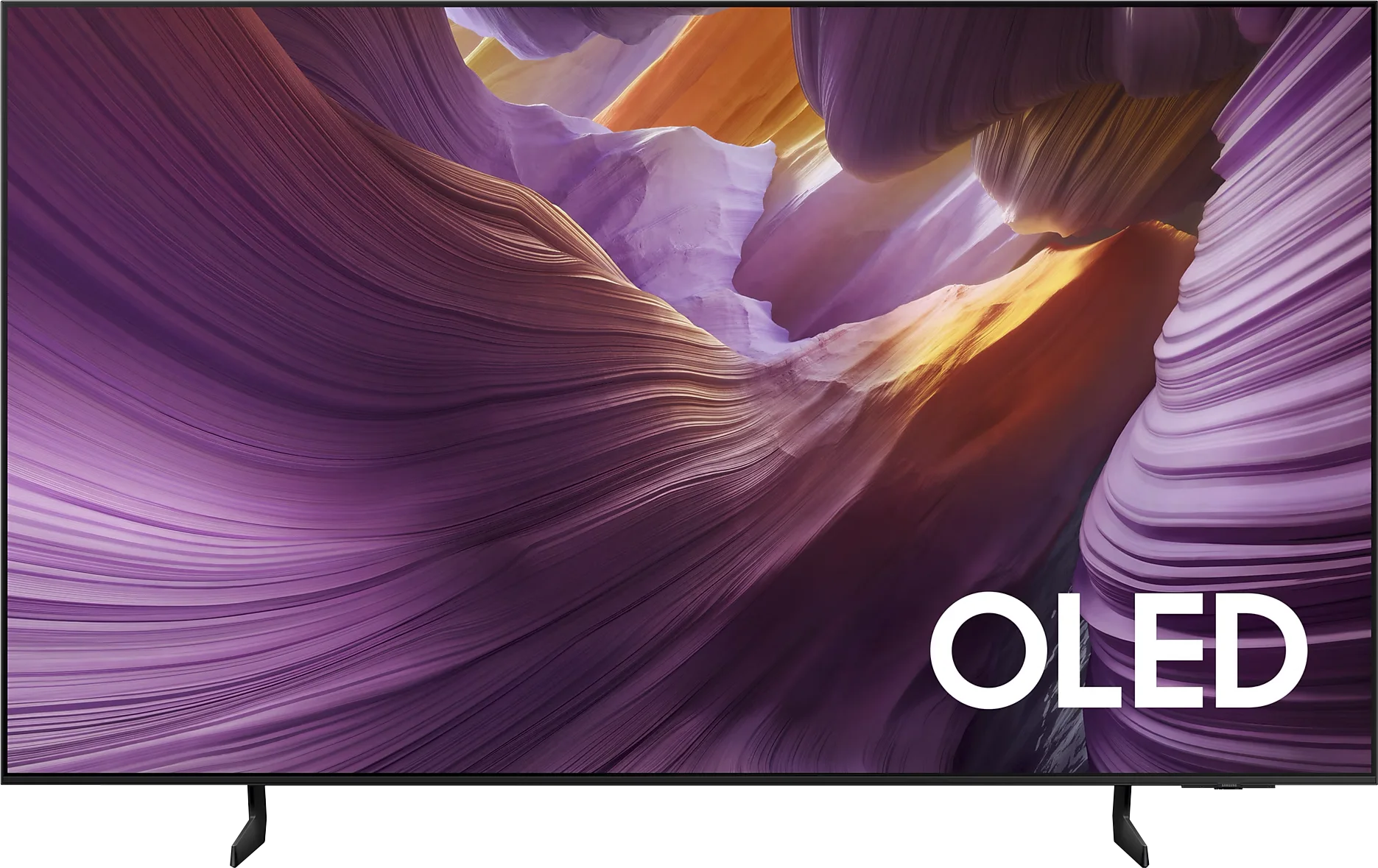
Panel type: LCD IPS
Resolution: 3840x2160
System: Titan OS
Model year: 2024
Complete the survey to find out the result

Panel type: QD-OLED
Resolution: 3840x2160
System: Tizen
Model year: 2025
Complete the survey to find out the result

Overall rating
6.8
8.0
Movies and series in UHD quality
6.6
8.3
Classic TV, YouTube
6.3
9.0
Sports broadcasts (TV and apps)
7.2
8.8
Gaming on console
8.5
9.3
TV as a computer monitor
8.0
7.6
Watching in bright light
6.1
5.1
Utility functions
6.1
7.3
Apps
6.2
8.7
Sound quality
6.4
7.2
Complete the survey to find out what fits your preferences
Advantages
Ambilight System: Triple-sided backlighting
120Hz Panel - smooth image
Additional features for gamers
Satisfactory level of brightness that works well during the day
Wide viewing angles
Amazing black and contrast
Incredible color palette coverage thanks to the QD-OLED panel
Great picture in SDR and HDR content
High color fidelity after calibration
Very good image smoothness – 120 Hz OLED panel
Rich set of features for gamers: VRR, Game Bar, low input lag
4 HDMI 2.1 ports with full bandwidth of 48 Gbps
Advanced and smoothly operating Tizen system
Solar Remote with multiple capabilities
Disadvantages
Poor black quality
Annoying "hybrid" remote
Titan OS: Still in development, with a limited number of applications and not very functional compared to more advanced platforms
No USB recording function and PiP
No Dolby Vision
Slight cherry black under very strong external light (not visible during viewing in cinematic conditions)
No HGiG function*
* This function disappeared with the software update 1110.7 – we are monitoring this situation continuously.
Our verdict
Samsung S85F with a QD-OLED panel can be surprising – and surprisingly positively so. Before the tests, we didn't think that in the case of televisions, which are often referred to in the context of "panel lottery," one could come across something beneficial for users. Yet, in this case, especially in the 55-inch version, it fully succeeded. The QD-OLED panel, as is fitting for organic technology, offers nearly perfect black and contrast in cinematic conditions. However, the difference lies in the way colors are reproduced – here it is simply outstanding. The color gamut coverage is impressive, and after slight calibration, the colors become almost exemplary. Motion smoothness is equally high. The 120 Hz panel handles both sports and action movies exceptionally well. And if someone plans to connect a console to the S85F, they will receive a full set of advantages: low input lag, variable refresh rate, Game Bar, and full HDMI 2.1 support. In daily use, we were assisted by the Tizen system – closed, but incredibly refined. It responds quickly, offers a rich selection of applications, and features such as AirPlay and voice control make it hard to find something more complete in this category. Indeed, the S85F is not without its flaws. However, the balance of advantages and disadvantages is exceptionally favorable here. One could even get the impression that this is one of the best televisions in its price segment.
TV appearance




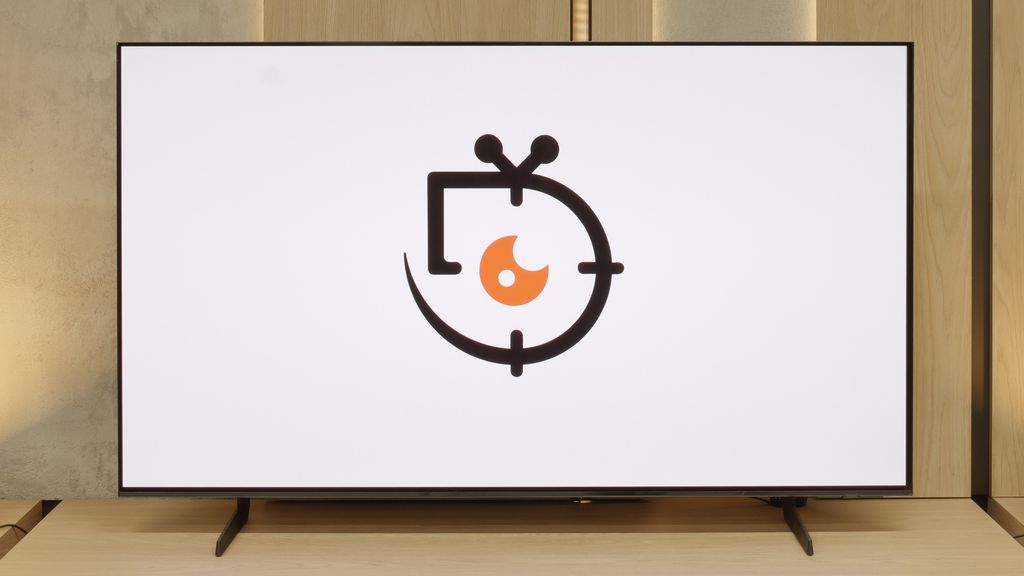
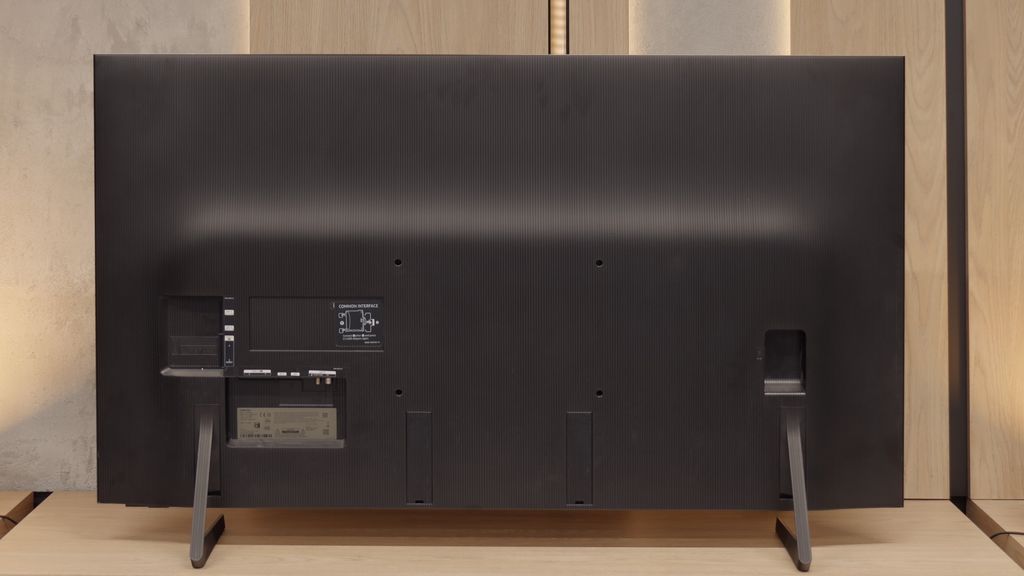
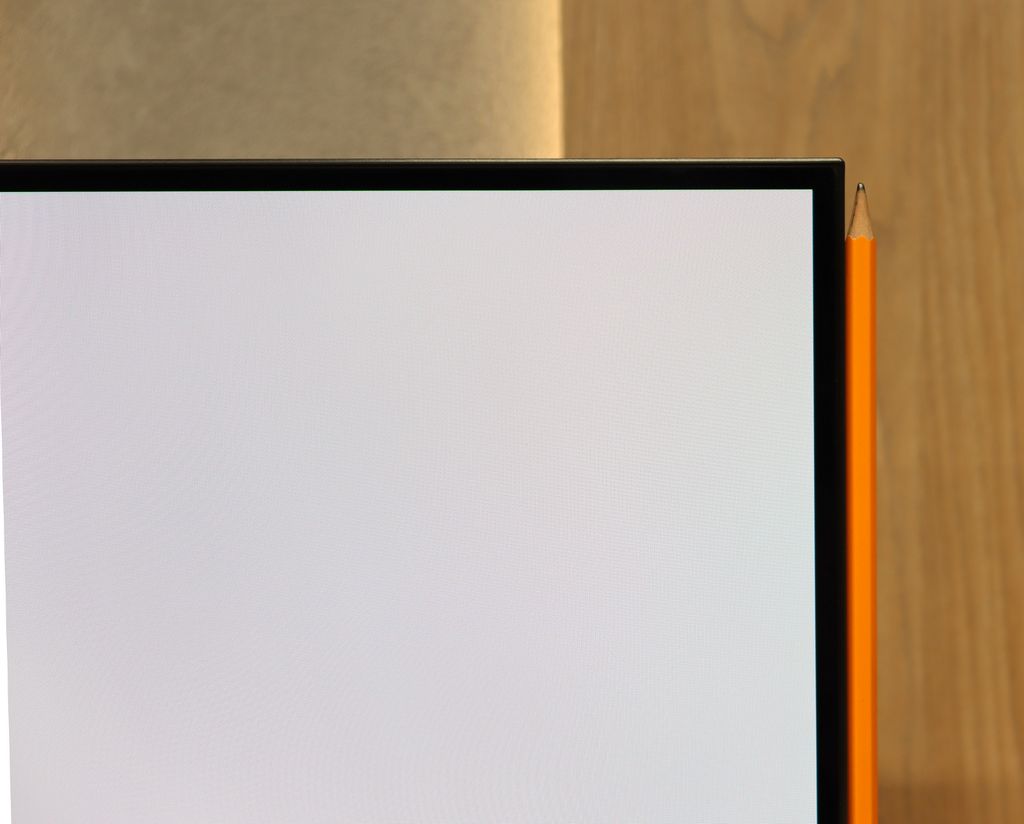
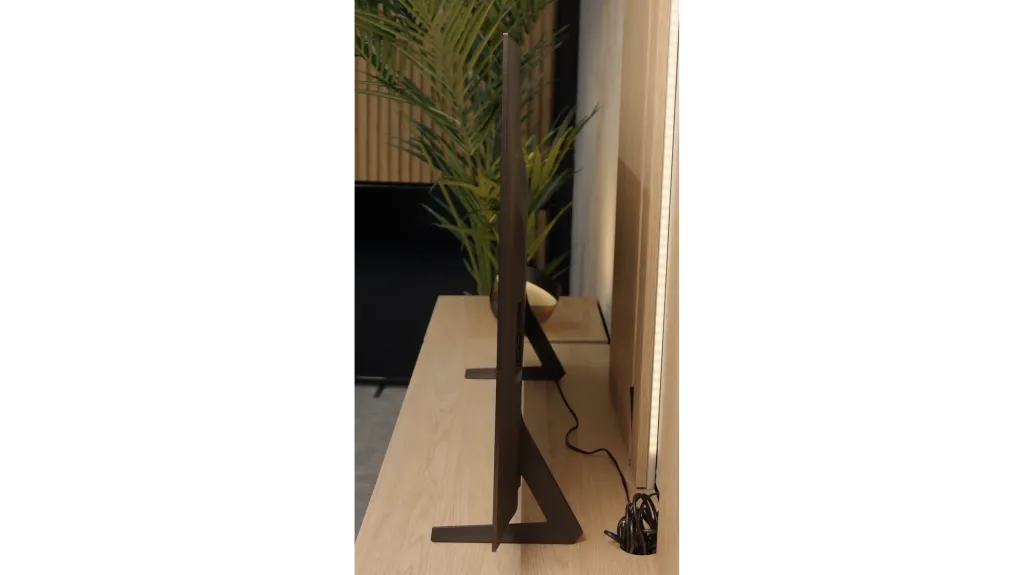
Where to buy
Contrast and black detail
4.3/10
10/10
Local dimming function: No
Contrast:

Result
2,350:1

Result
2,400:1

Result
2,600:1

Result
2,550:1

Result
2,200:1

Result
∞:1

Result
∞:1

Result
∞:1

Result
∞:1

Result
∞:1
Halo effect and black detail visibility:

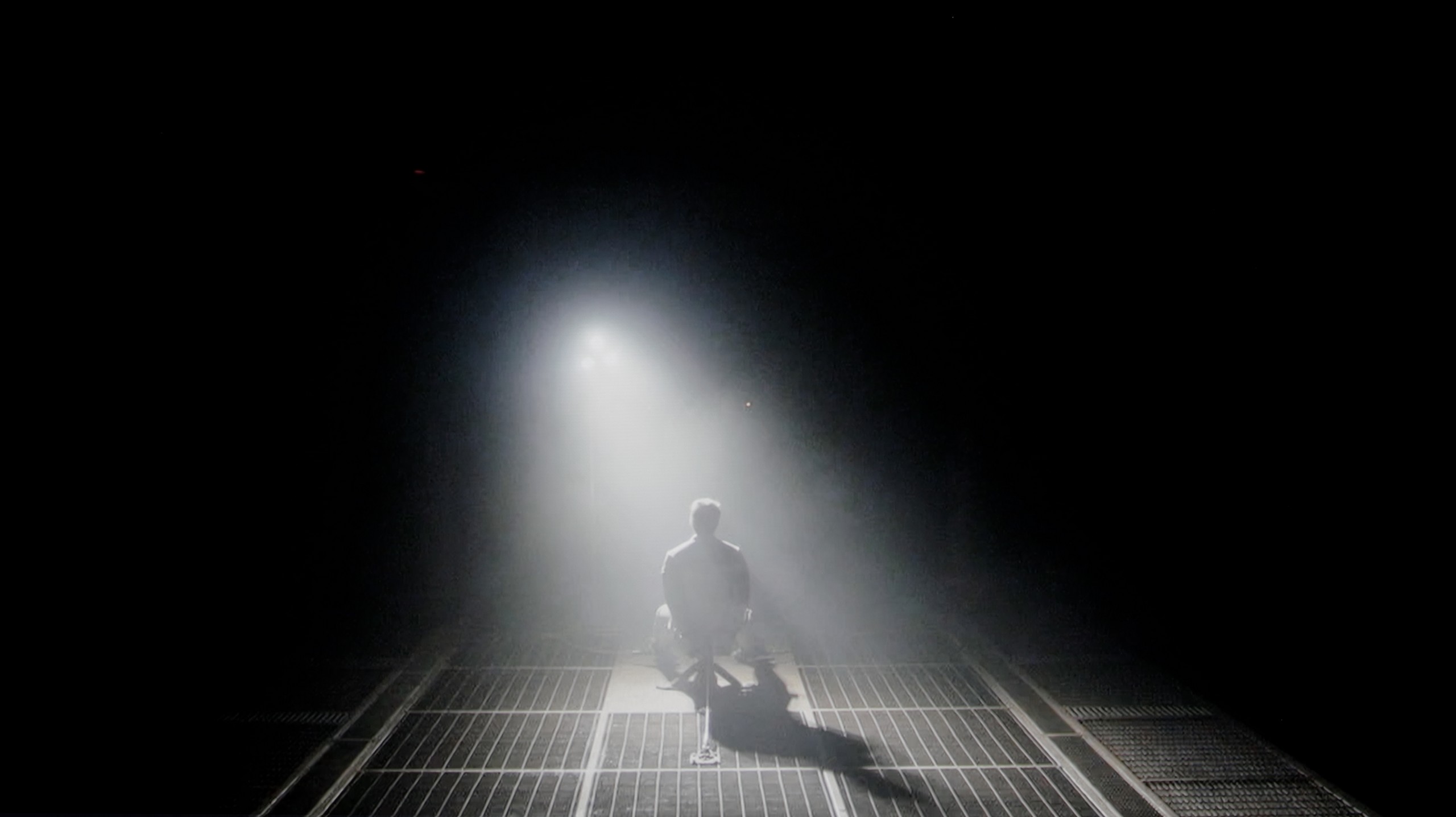
The television Philips PUS8959 is based on an ADS panel, which offers slightly different parameters compared to the popular VA panels. In the tested scenes, the contrast was around 2000:1, making the black level far from ideal. ADS panels are known for their weaker contrast compared to VA panels, which in practice means that instead of deep black, we see more navy or gray shades. However, the ADS panel is still better than the standard IPS panel, which cannot achieve such a level of contrast. Additionally, the Philips PUS8959 is not equipped with local dimming technology that could improve these parameters. The lack of this feature amplifies the effect of shallow black, particularly noticeable in dark scenes, like those in the movie "Sicario 2." Instead of intense black, the screen generates a silvery glow, which can be bothersome, especially when watching in darker conditions. All of this makes the visual experience lose depth, and details in dark scenes are not as well visible as one might expect from higher-class screens. Despite the lack of local dimming, the television is equipped with something called Global Dimming. The television is capable of completely dimming the panel to achieve higher contrast, but at the expense of details that may blend together, for example, lights in the test scene from the movie Oblivion. It is worth adding that the model we received for testing has quite large spots resulting from uneven backlighting, although this is not an exception, and one should take into account that we might also receive such a unit when purchasing.
The Samsung S85F in the 55-inch version has something exceptional – it features a QD-OLED panel. This sounds quite surprising, but that’s the fact, at least in Poland. So the question arises: is the difference from last year's S85D with a WOLED panel even noticeable? Yes, although in this particular test – black levels and contrast – it practically makes no difference.
Regardless of the scene, the S85F delivers infinite contrast and perfect black levels that we expect from any OLED. These results can amaze even the most demanding movie enthusiasts. It’s worth noting that such deep blacks can only be offered by televisions with organic panels – and it doesn’t matter whether it’s WOLED or QD-OLED. So, if you dream of a screen that can "turn off" the light in a scene as effectively as an independent cinema in a dark room, the S85F is one of those televisions.
HDR effect quality
5.9/10
6.2/10
Luminance measurements in HDR:

Result
501 nit

Result
514 nit

Result
553 nit

Result
544 nit

Result
569 nit

Result
666 nit

Result
703 nit

Result
742 nit

Result
732 nit

Result
433 nit
Scene from the movie “Pan” (about 2800 nits)


Scene from the movie “Billy Lynn” (about 1100 nits)


Static HDR10


Dynamic: Dolby Vision
Dynamic: HDR10+


HDR luminance chart:
Samsung OLED S85F (QD-OLED)
HDR luminance
Philips The One (PUS8959 / PUS8919 / PUS8909 / PUS8949
HDR luminance
The luminance chart for Philips PUS8959 shows that the television can achieve around 550 nits of brightness, which can be considered a satisfactory level. This brightness allows the effects of HDR to be felt, particularly standing out in more demanding scenes. In the tested patterns, the television performed quite well, even in challenging sequences like those from "Sicario 2". Due to the lack of local dimming, the television does not dim small bright elements, and they shine with the full "power" of the television but at the cost of the silverish blacks we mentioned in the paragraph about blacks. It is also worth praising Philips PUS8959 for its good coverage of the DCI-P3 color palette, which amounts to around 94.5%. This makes the colors vivid and close to the creators' intentions, further enhancing the quality of HDR effects and the viewing experience of high dynamic range content.
As an OLED, the Samsung S85F can really shine – literally. Under favorable conditions, it can generate brightness exceeding 750 nits. This is hugely significant because most movies are created with displays around 1000 nits in mind. In practice, this means that in scenes with moderately large bright elements, the image can look simply fantastic. However, it's not always so rosy. When there is a massive amount of light on the screen – whether it's a vast bright background or an entire screen filled with white – the S85F must tone it down. The brightness can drop by even four times in such scenes. This limitation is known to basically every OLED in this price range, so we don't consider it a particular failing. However, something that deserves praise is what sets this model apart from the competition – color gamut coverage. Thanks to the QD-OLED panel, our colorimeter showed values exceeding 100% DCI-P3 coverage and as high as 86% for the ultra-wide BT.2020 palette. Such results are hard to find even in televisions that cost several times more.
Factory color reproduction
4.1/10
5.5/10


Factory Mode
After calibration


Factory Mode
After calibration
The Philips PUS8959 television was tested in the best, theoretically most precise picture mode – Filmmaker. Although the name suggests cinematic quality, it unfortunately falls far short of the ideal. The biggest issue in this mode is white balance, both in HD and 4K content. It is characterized by a significant dominance of the red color and dips in the green level, resulting in an unnatural color reproduction. For example, white elements of the image have a distinctly pinkish hue, and the green is less intense, causing the overall image to lose its naturalness and color balance. The ColorChecker test confirms these errors – it is clearly visible how the color samples "deviate" from the correct values, which can be best observed on the sample squares that should accurately reproduce colors. The lack of accuracy in this regard affects the realism and fidelity of the image, which is particularly undesirable in Filmmaker mode.
Regarding brightness characteristics, the gamma chart resembles a real roller coaster – with small elements displayed on the screen, the brightness is excessive, causing details to become overly highlighted. Meanwhile, at higher gamma values, the image loses contrast and becomes too dark, making the overall appearance look less dynamic. Similar issues can be noticed in the EOTF characteristics – the television is unable to correctly reproduce the brightness level, negatively affecting the overall image quality.
Samsung, as befits a manufacturer with ambitions, equipped the S85F with a mode called Filmmaker. Its task is simple: to make the colors on the newly purchased television as true to what the director wanted us to see as possible. Sounds great… but, as often happens, a great-sounding theory doesn’t always translate into perfect practice.
In the tested unit, it quickly became apparent that the image – due to an excess of blue and red – looked as if someone had overdone the saturation a bit. As a result, quite significant color errors appeared, particularly in 4K content. To make matters worse, there was a brightness issue – the S85F could brighten most scenes more than it should, taking away their intended mood.
Fortunately, Samsung televisions, including the S85F, offer an impressive number of settings for advanced calibrators. This means we could check what this panel is truly capable of when it gets into the right hands.
Color reproduction after calibration
8.1/10
9.3/10

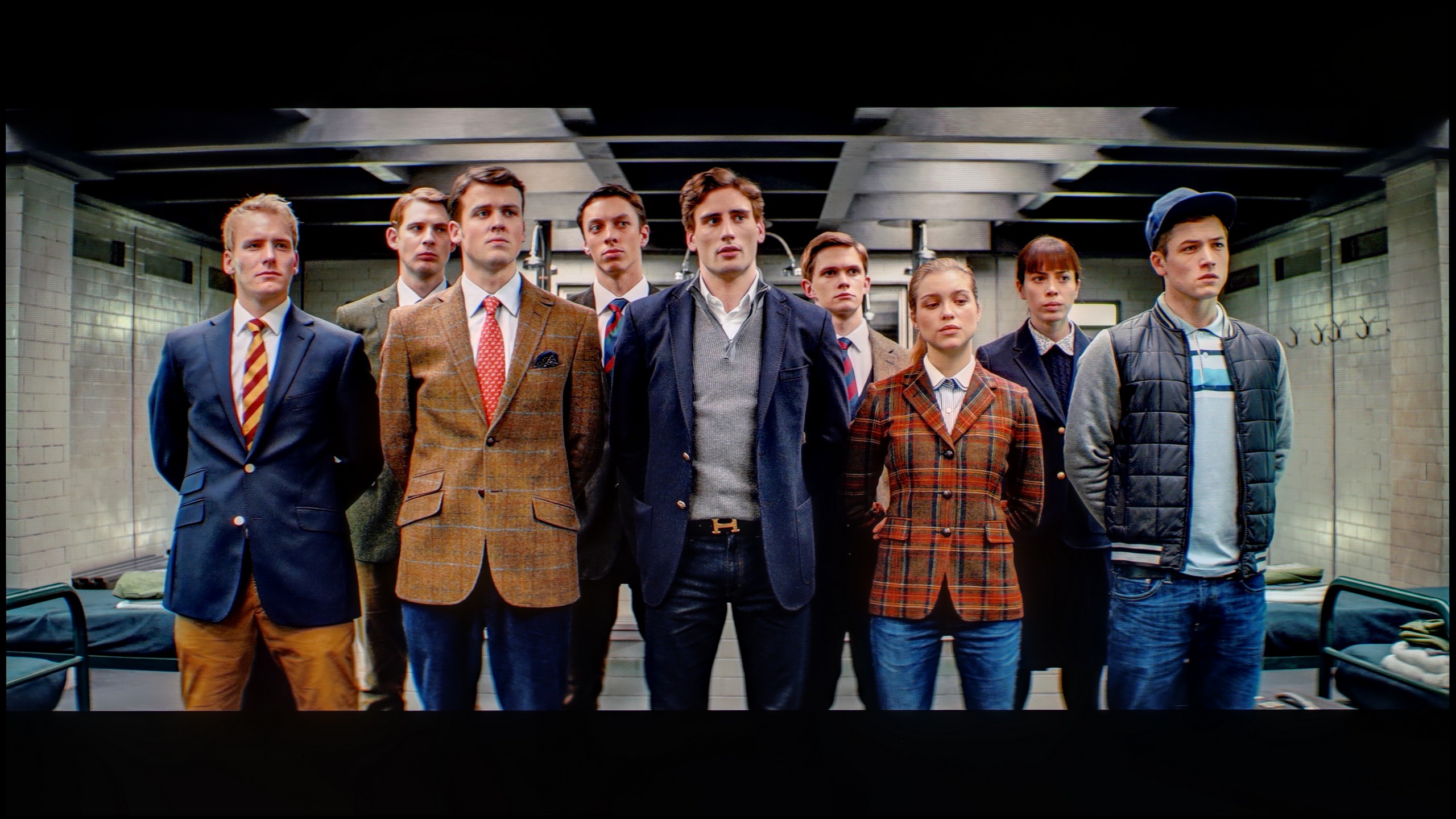


After calibration, the Philips PUS8959 television shows a significant improvement in color reproduction, especially in HD content. The white balance is exceptionally even, and the Delta E error values are below 1, which can be considered an outstanding result. Additionally, the gamma, which is responsible for brightness in lower-quality materials, performs very well, maintaining a stable level at 2.4, leading to an appropriate balance between bright and dark areas of the image.
Regarding 4K HDR materials, a significant improvement is also noticeable. The white balance, although not as perfect as in HD content, no longer shows issues with excessive red exposure, making the image appear more natural and harmonious. Unfortunately, in the EOTF characteristics, it is difficult to speak of any significant improvement, due to the design limitations of the television that prevent significant enhancement in this aspect.
Nevertheless, the overall performance is much better after calibration, making the Philips PUS8959 one of those televisions where it is truly worth spending time on precise calibration to achieve satisfactory image quality.
Thanks to the vast number of settings in the menu, we managed to bring the S85F almost to perfection. White balance in SDR content? Literally perfect – deviations do not exceed a value of "1". Thus, it can be confidently said that in materials with not very high dynamics, we have an image close to reference.
In HDR content, minor issues did arise, but they are of little significance in practice – most errors fall below the threshold of perception, which is a value of "3". We also managed to tame the S85F regarding brightness management – the EOTF curve, even in films, adheres to an almost perfect line. This is one of those cases where after calibration, you can comfortably forget about the settings and simply enjoy movies and series at the highest level.
Smoothness of tonal transitions
8.9/10
7.9/10












The gradation on the Philips PUS8959 television looks very good, offering smooth tonal transitions in most scenes. Occasionally, minor issues can be noticed, especially during transitions between certain colors, where subtle unevenness is apparent. However, these imperfections are subtle enough that they do not significantly impact the overall viewing experience and can be considered completely acceptable. In everyday use, the television provides sufficiently good gradation quality to satisfy even more demanding users, maintaining the naturalness of the image and avoiding glaring tonal distortions.
Thanks to the QD-OLED panel, the color blending on the S85F performs really well. It's especially worth noting how it handles the darkest, most demanding scenes – where most televisions start to struggle, this model works almost perfectly.
Interestingly, a minor stumble can be noticed in those easier, brighter shots. There is a slight banding of colors, but it's so subtle that it's hard to believe it would actually bother anyone while watching.
Image scaling and smoothness of tonal transitions
6.5/10
7/10
Smooth transition function

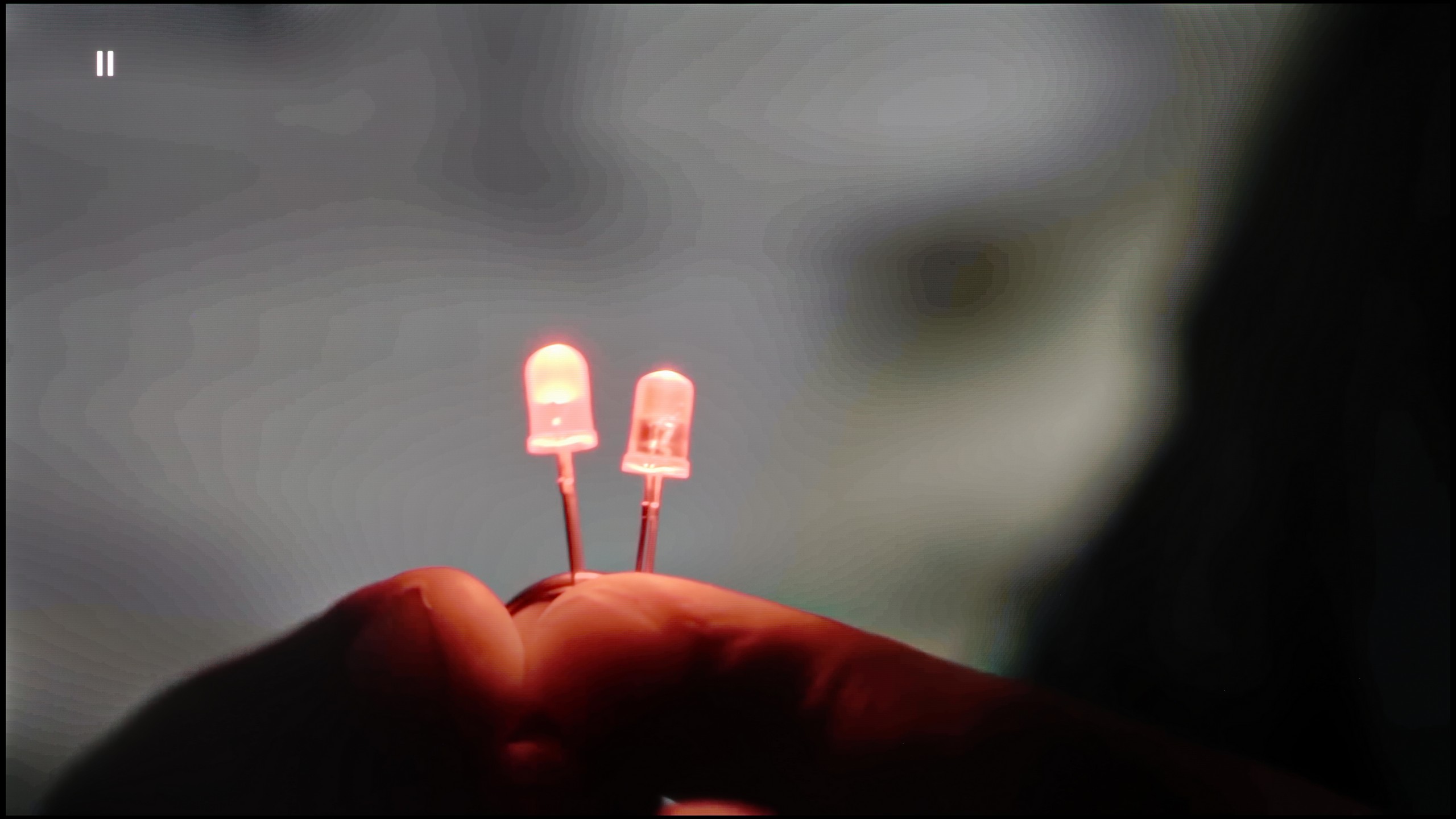
Image without overscan on the SD signal


When it comes to smoothing tonal transitions, the "Distortion Reduction" function at the minimal setting performs quite well, effectively smoothing tonal transitions without excessive influence on other elements of the image. In tests, I did not notice that the reduction negatively affected the image structure, such as film grain or object details – everything remains in place, which is a big plus for users who appreciate the natural look of film materials.
On the other hand, regarding digital processing, the image looks quite good, although it is characterized by very softened contours, giving it an almost "misty" quality. This effect can evoke mixed feelings – some users may enjoy the fluidity and delicacy of this type of presentation, while others may find it too gentle, losing detail. It is a matter of individual preferences, but it must be admitted that the Philips PUS8959 provides quite subtle yet effective tools for improving tonal transitions without excessive interference in the natural character of the image.
The tone transition smoothing feature in the S85F works really well – it can completely eliminate the problem of visible bands in very poor quality materials, even from YouTube. Unfortunately, even the lowest level of this option comes with compromises. Noise reduction is aggressive enough that it can smooth out film grain, which many of us consider an element of the cinematic atmosphere. At the "Standard" level, we did not notice that this feature removed anything significant from the image, so we can recommend this setting. On the other hand, the "High" level is a different story – it can smooth not only noise but also fine, desirable details such as the texture of objects.
When it comes to image scaling, the S85F performs very well. The material looks sharp, and the only minor imperfection is slightly visible contour jaggedness. And there’s the ongoing issue with Samsung televisions – overscan. This can cause some scenes to have their frames slightly trimmed, which is worth keeping in mind when watching very old content.
Blur and motion smoothness
8/10
8.5/10

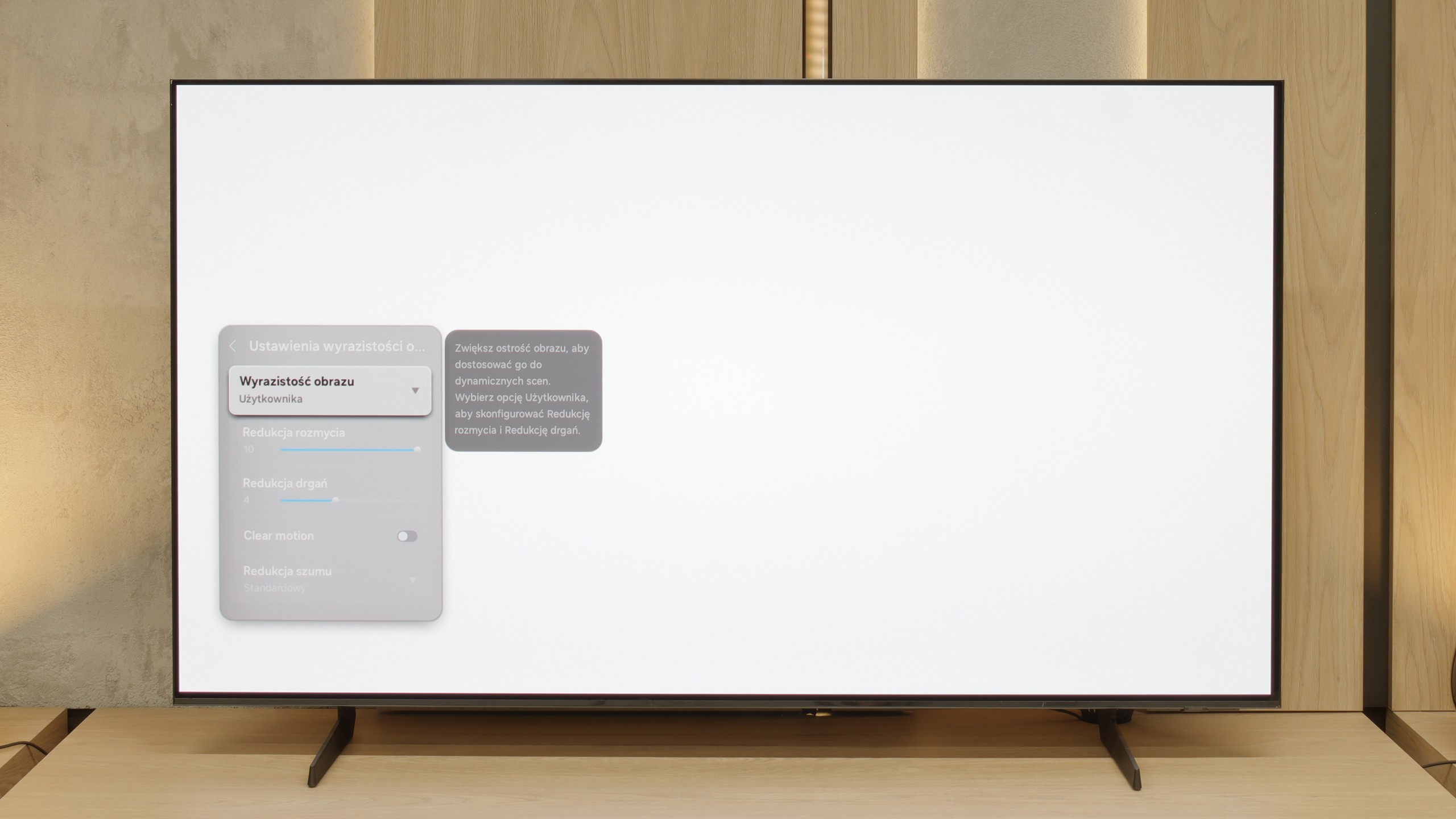
Blur (native resolution, maximum refresh rate):






Blur (BFI function enabled):
Image flickers in this mode


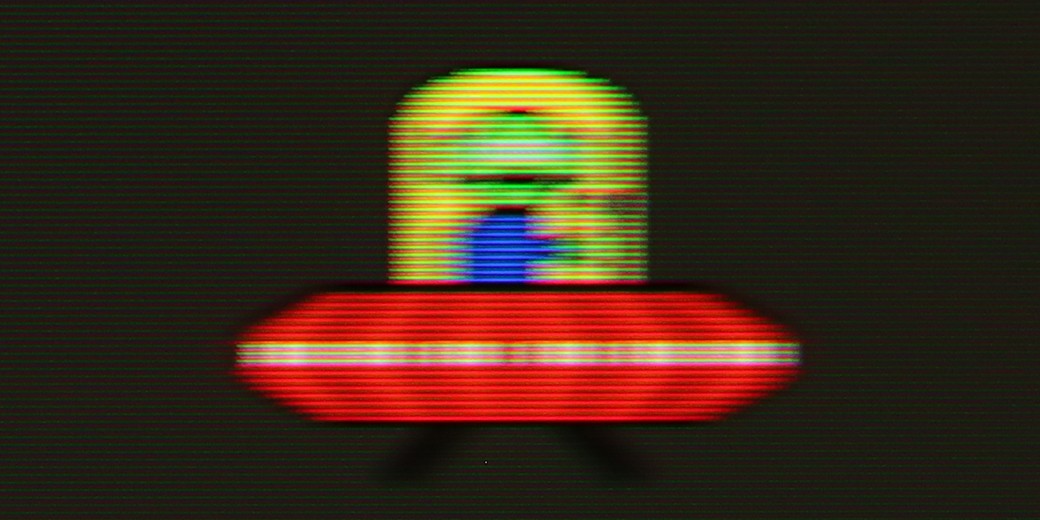
Smużenie ():
Smużenie (4K@60Hz Game Motion Plus):
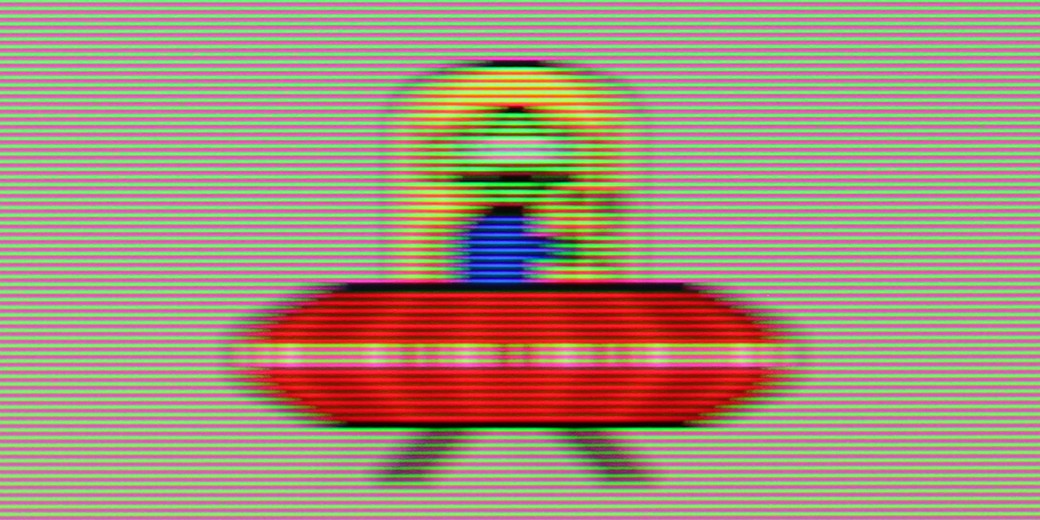
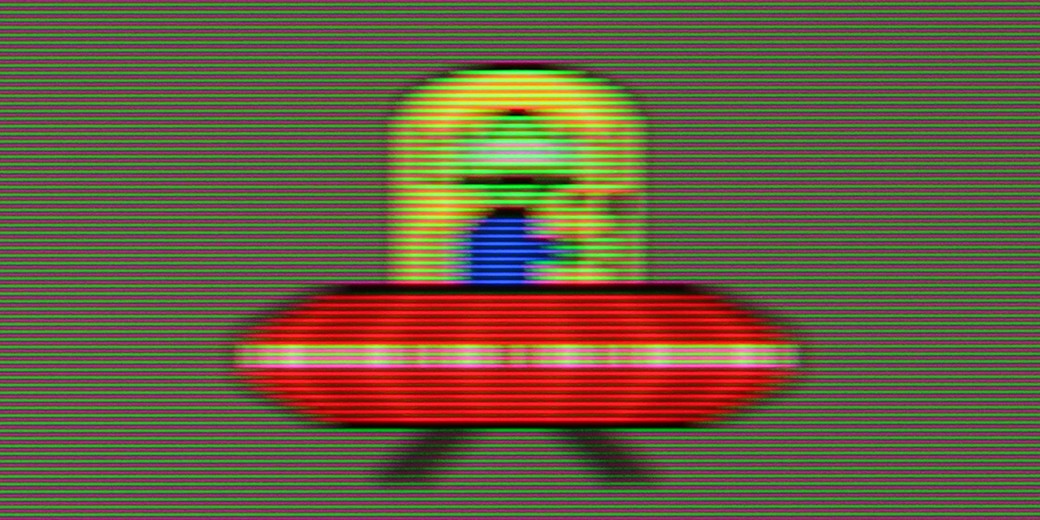
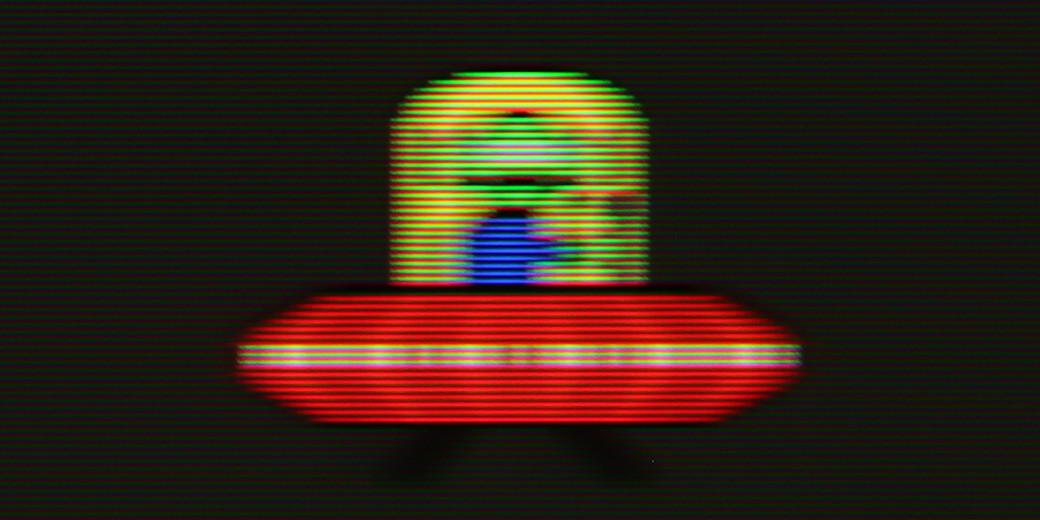
Philips TV PUS8959 is equipped with a 120 Hz panel, which should satisfy more demanding users, especially those who love watching dynamic sports broadcasts or playing games. Such a high refresh rate allows for a significantly smoother image, being a key aspect during dynamic scenes and fast actions.
For those who prefer watching movies, the TV offers an additional motion smoother that allows adjusting the frame rate of the film according to personal preferences. The Philips PUS8959 has a 10-step adjustment for the functions called "Smoothness" and "Motion Blur Reduction." The "Smoothness" function is responsible for increasing the number of frames through interpolation, making motion on the screen smoother, resembling the effect of so-called "soap opera." Meanwhile, "Motion Blur Reduction" focuses on minimizing blurring and improving motion sharpness, which is particularly noticeable in dynamic sequences, such as action scenes or fast sports shots.
S85F is a hellishly fast television – and this is not just an empty catchphrase for effect. Thanks to the 120 Hz OLED panel, dynamic scenes, whether in games or while watching a live match, look exactly as they should – smoothly, sharply, and without the feeling that something is "escaping" from the frame. The lightning-fast pixel response time, typical of OLEDs, plays a crucial role here. Transitions between frames are practically instantaneous, and the image remains clear even during the fastest camera movements. A ball flying across half the field? A car racing in a chase scene? Everything here is clear and free of the characteristic "trail" found in LCDs.
This is exactly what we expect from a good OLED – zero compromises in motion fluidity. The S85F gives the feeling that regardless of the pace of the action, we can focus on what is happening on the screen, rather than on the imperfections of the image.
Console compatibility and gaming features
9.8/10
8.2/10
- ALLM
- VRR
- VRR range48 - 144Hz48 - 120Hz
- Dolby Vision Game Mode
- Correct implementation of HGIG
- 1080p@120Hz
- 1440p@120Hz
- 4K@120Hz
- Game bar

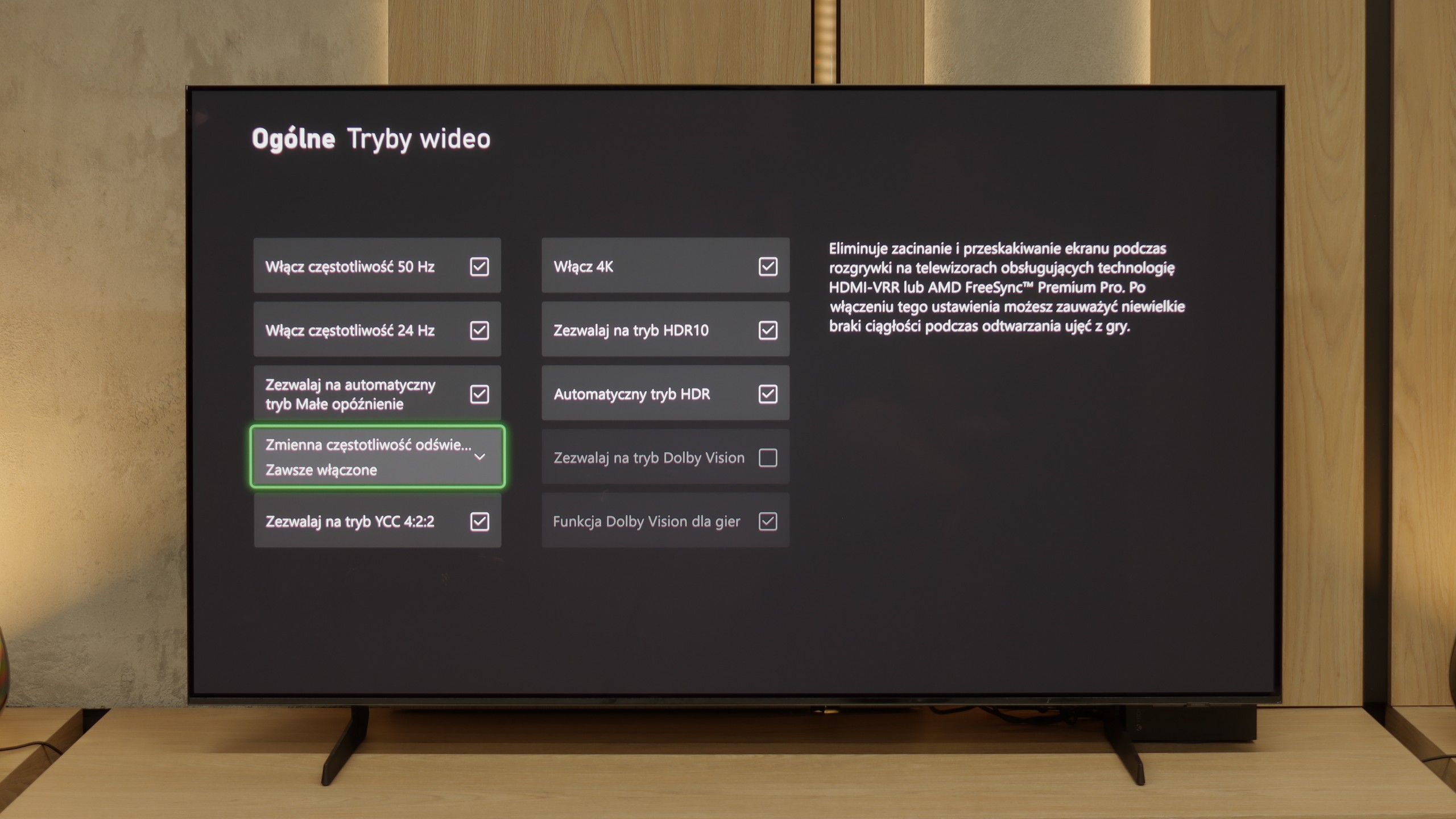

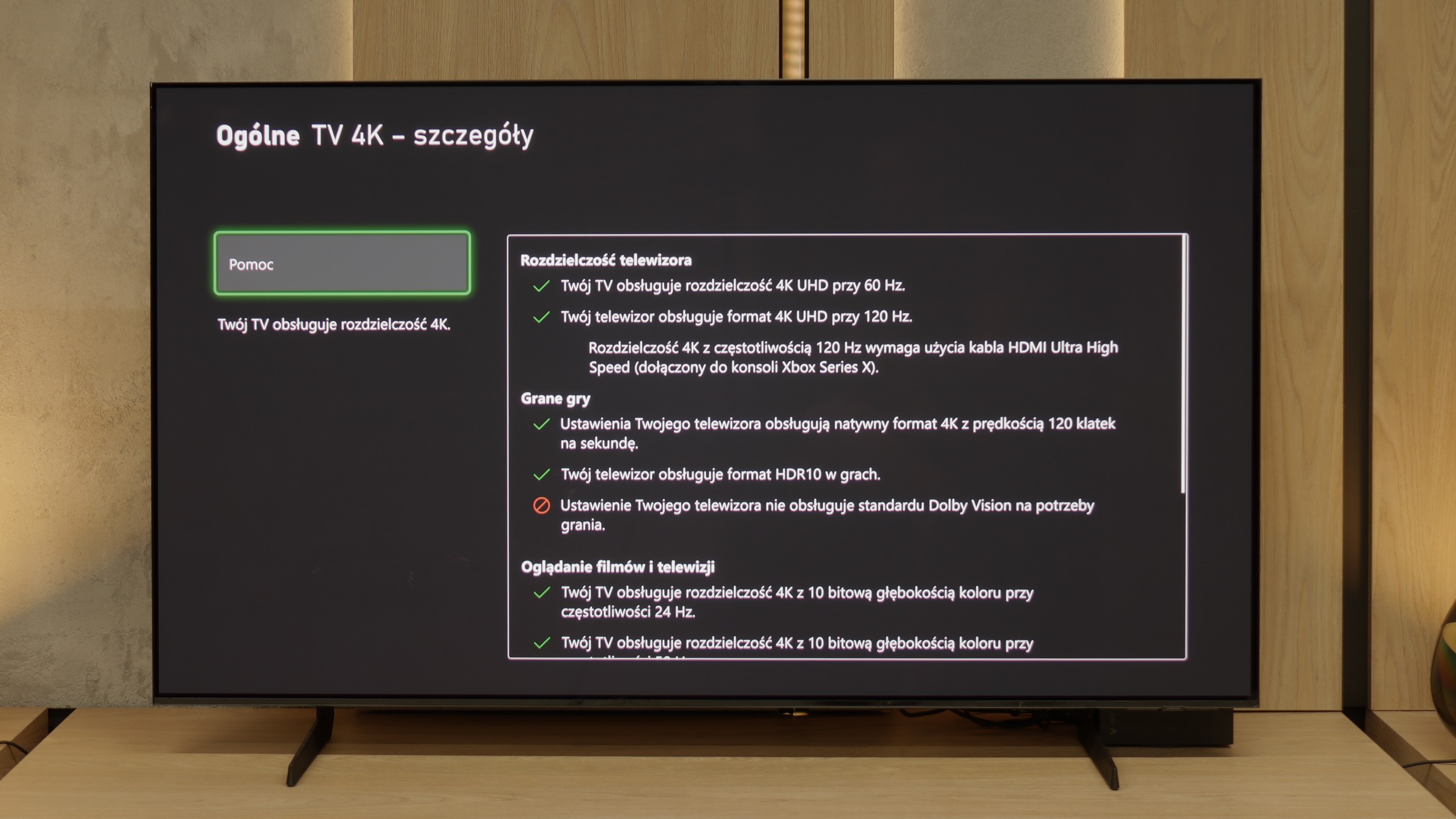

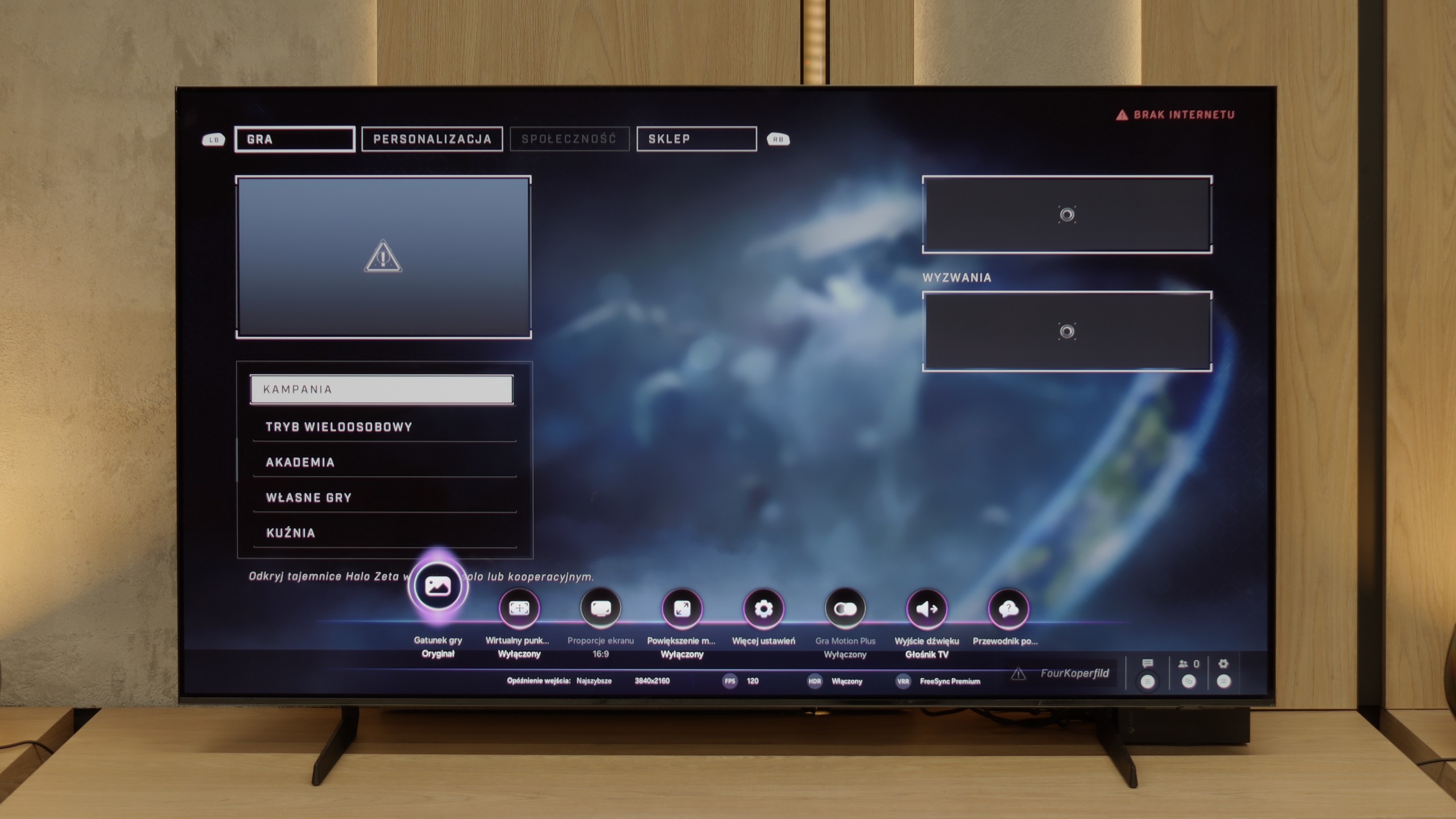

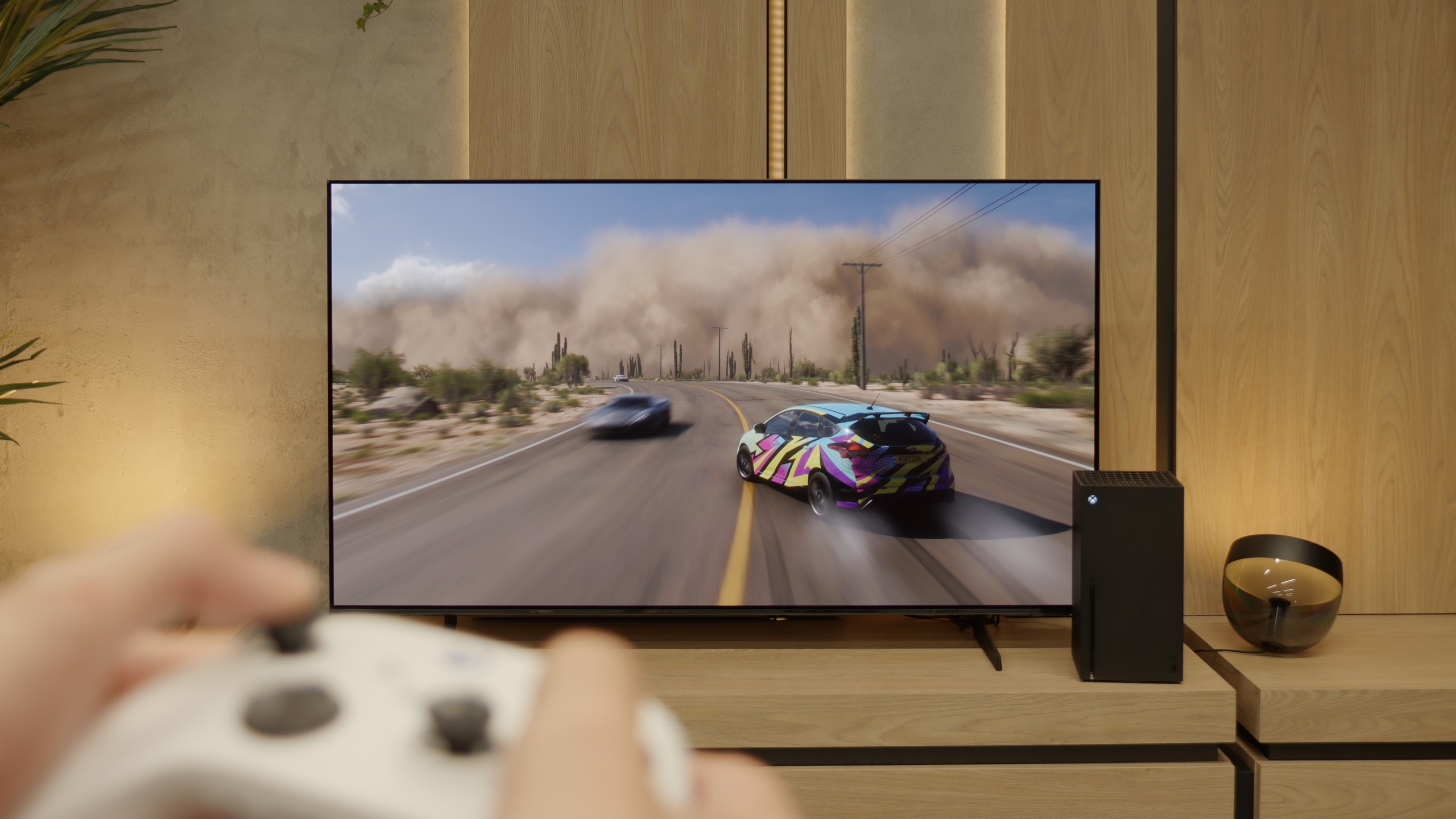
Philips PUS8959 is a television that will certainly satisfy gaming enthusiasts. It supports most modern technologies useful during gameplay, such as HGiG, allowing for better HDR effect reproduction in games. As a result, the image is closer to what the game developers intended to achieve.
The television also supports 120 Hz image display, ensuring smoothness and dynamism, which is particularly important during action games and sports broadcasts. The Game Bar feature provides quick access to game settings, making it easier to adjust the image according to user preferences without interrupting gameplay.
Unfortunately, the Dolby Vision mode does not offer low input lag, which may be noticeable during dynamic scenes. Nevertheless, thanks to the HGiG feature and high refresh rate, the Philips PUS8959 remains an attractive choice for gamers, offering good image quality and appropriate smoothness during gameplay.
The S85F has practically everything it needs to become the dream screen for gaming. Four fully-fledged HDMI 2.1 ports with a bandwidth of 48 Gb/s, support for VRR, ALLM, a super-detailed Game Bar that clearly shows all parameters – and on top of that, a gem in the form of Game Motion Plus. This is a motion interpolator that makes animation in games more enjoyable, with only a slight increase in input lag. This is a rare combination, and Samsung deserves a big plus for it.
Now comes the moment where we have to complain a bit. The lack of Dolby Vision in Samsung TVs is already standard, so there's no point in hoping (unless something changes in a few years) – but the disappearance of HGiG after the software update is something that’s hard to explain. HGiG (which stands for HDR Gaming Interest Group) is a mode that allows for precise reproduction of brightness in HDR games, according to the creators' intention. Without it, HDR calibration on the console becomes less precise, so we might end up with an image that's too dark in the shadows or overly bright.
Perhaps Samsung will fix this in the next update – and we have high hopes for that. Because if HGiG returns, the S85F will become almost the perfect TV for gamers.
Input lag
9.7/10
10/10
SDR
HDR
Dolby Vision
Philips PUS8959 TV offers impressive results in terms of input lag, making it an excellent choice for gamers. For 120 Hz content, the lag is less than 6 ms, which is an absolutely outstanding result and allows for immediate reactions in games, especially in fast-paced titles. For 60 Hz content, the input lag is 15 ms, which is also a remarkable result and provides comfortable gameplay in most cases.
Unfortunately, the Dolby Vision mode does not perform as well, as the input lag increases to 31 ms. While this result may be acceptable for less dynamic content, it may prove insufficient for demanding gamers, affecting precision and reaction speed. Nevertheless, in standard modes, Philips PUS8959 still offers outstanding performance, making it a competitive choice in the gaming TV market.
Here, dear gamers, the S85F shows its claws. 5 ms with 120 Hz content and about 10 ms with 60 Hz are results that can be described in one word in the world of televisions – phenomenal. This means that the response to our movements is practically instantaneous. We press the button, and the action on the screen happens without any delay, as if the television were reading our minds. In dynamic games, where a fraction of a second can determine victory or defeat, such values make a huge difference. There is no question of a nervous "wait" for the image to catch up with our movements. The S85F gives us the feeling that everything is under our complete control – and that's how it should be with equipment that aspires to be the ideal screen for gamers.
Compatibility with PC
8/10
7.6/10

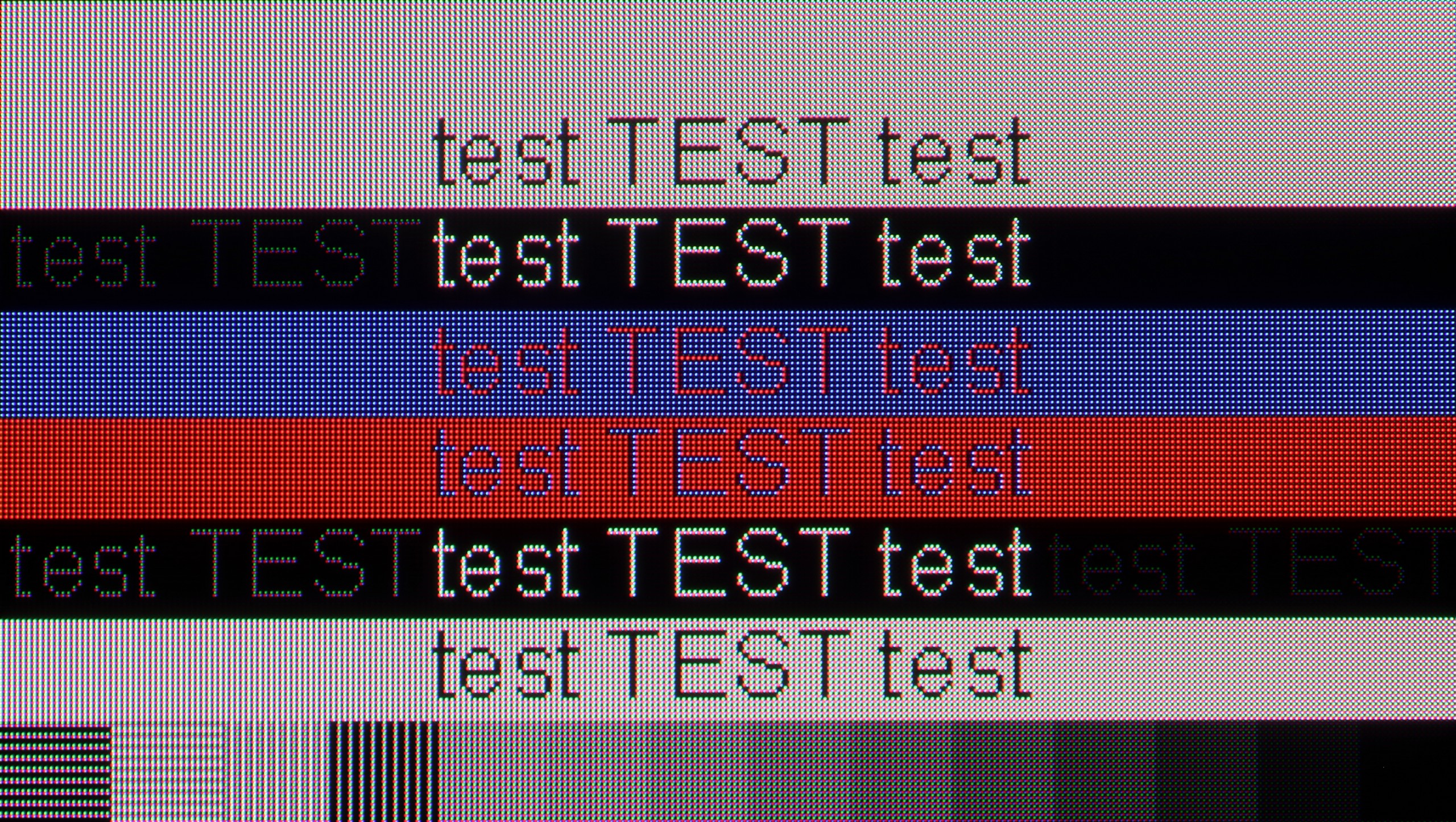
Philips PUS8959 performs excellently as a monitor for use with a PC. With support for chroma 4:4:4, it provides full color clarity, which is crucial for working with text – fonts are sharp and legible, regardless of the background they are on. This makes using office applications, browsing the internet, and graphic editing comfortable and precise.
Additionally, the low input lag offered by the television guarantees smooth and responsive operation, which is important for both everyday tasks and more dynamic applications, such as gaming or multimedia editing. Philips PUS8959 is an excellent choice for users seeking a television that will also serve as a PC monitor, providing high image quality and user convenience.
If you plan to connect the S85F to a computer, we have good news – this television is perfect for that. Low input lag and a 120 Hz panel make gaming on a PC pure pleasure. Whether we're talking about dynamic shooters or calmer RPGs, the response is instantaneous, and the fluidity of animations can keep you engaged for hours.
Of course, there’s no rose without thorns. Due to the diamond pixel arrangement in the QD-OLED panel, there is a slight “rainbow icon” effect, particularly noticeable when sitting close to the screen. Fortunately, this is more of a detail that most of you won’t mind in everyday use. Especially since, thanks to the proper implementation of chroma 4:4:4, the readability of fonts is at a very good level – documents, websites, and text editors look just as they should.
Viewing angles
6.9/10
9.8/10
Philips PUS8959, equipped with an ADS panel, offers quite good viewing angles, definitely better than those found in VA panels. The image retains its quality even when viewed from a greater angle – colors are vivid, and contrast does not deteriorate as much as in televisions with VA panels. As a result, when watching television from different spots in the room, one can still enjoy well-saturated colors and overall image quality, making Philips PUS8959 a perfect choice for larger spaces and for watching together with family or friends.
Here, dear readers, the S85F reaches absolute heights. The viewing angles are phenomenal – some of the best you can get in a television today, thanks to the unique QD-OLED panel from Samsung Display. Of course, WOLED panels can also maintain a high standard in this regard, but let's not kid ourselves – what QD-OLED shows in the S85F is even more impressive. Colors, contrast, and brightness remain practically unchanged even when watching the screen from a very large angle. This is the kind of television where you don't have to fight for the "best spot on the couch" – everyone will see the picture in all its glory, no matter where they sit.
TV efficiency during daytime
6.1/10
5.1/10

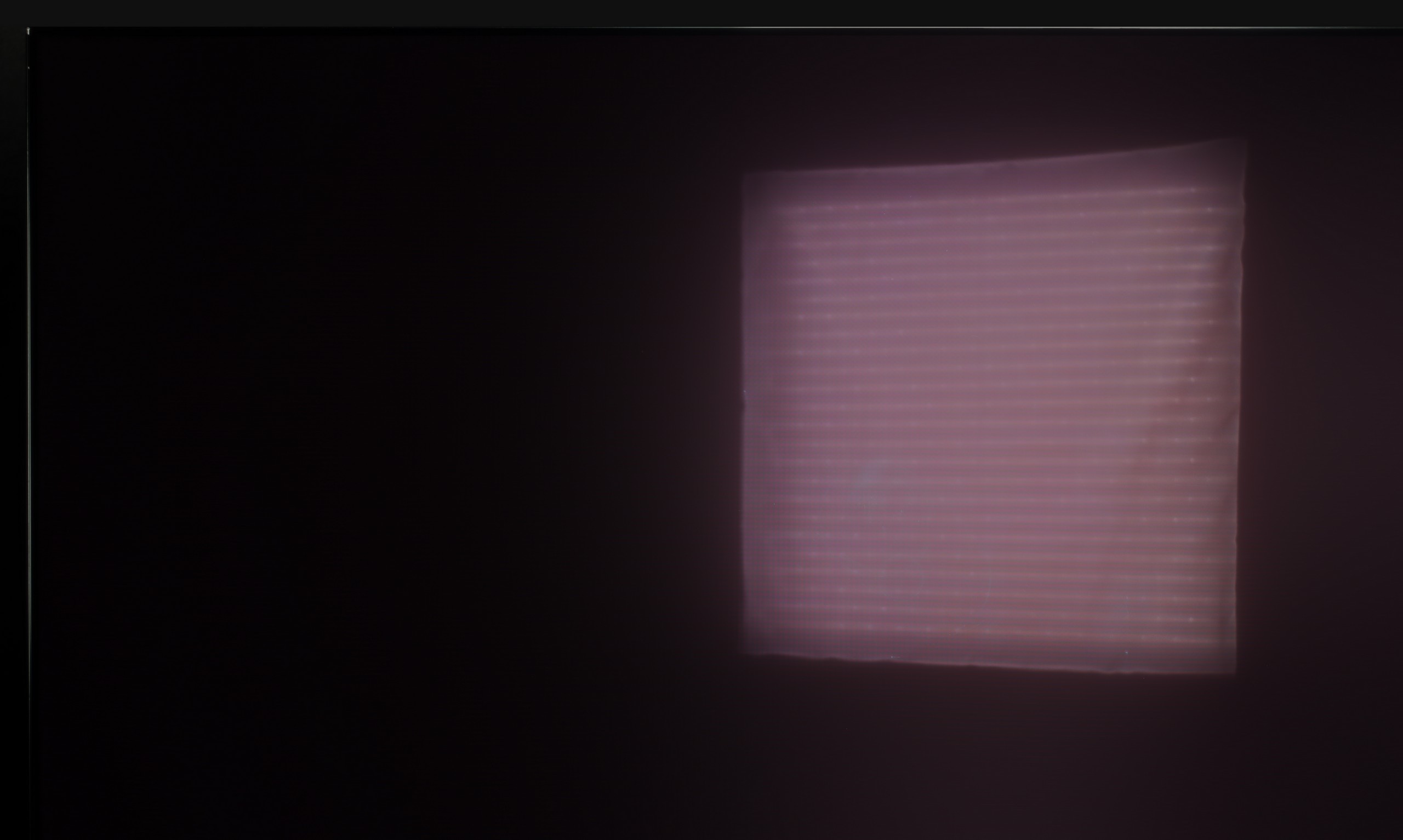


Matrix brightness
Average luminance SDR
Samsung OLED S85F (QD-OLED): 317 cd/m2
Philips The One (PUS8959 / PUS8919 / PUS8909 / PUS8949: 562 cd/m2
Philips PUS8959 has a satin coating on the screen that effectively reduces light reflections, which is advantageous when using the television in bright daylight conditions. However, such a coating causes blacks to take on shades of gray during the day, losing their depth and intensity, which affects the perception of the image in darker scenes.
A brightness level of 562 cd/m² allows for comfortable television viewing during the day, even in well-lit rooms. The image is bright enough to stand out against daylight, and the reduction of reflections ensures decent visibility of content, making Philips PUS8959 a good choice for rooms where lighting levels cannot always be controlled.
We really liked the saying "there's no rose without thorns," and it perfectly fits the QD-OLED TVs. Especially when we take a look at their performance in heavily sunlit conditions. As you may notice, in very bright light, the panel's surface can take on a slightly cherry hue. The effect is subtle in the case of the S85F, but in extreme lighting conditions, black can perform a bit worse than in WOLED panels. But - and this "but" is key here - QD-OLED significantly better suppresses direct reflections of light. This means that reflections will be less bothersome, and the image will maintain clarity even when something bright reflects off the screen. You gain some, you lose some.
When it comes to brightness, the S85F is a moderately bright OLED. It's not a model made for extremely sunlit living rooms. If you plan to place it in a very bright room, we recommend considering shades or positioning it in a place that provides at least some protection from direct light.
Details about the matrix
Subpixel Structure:

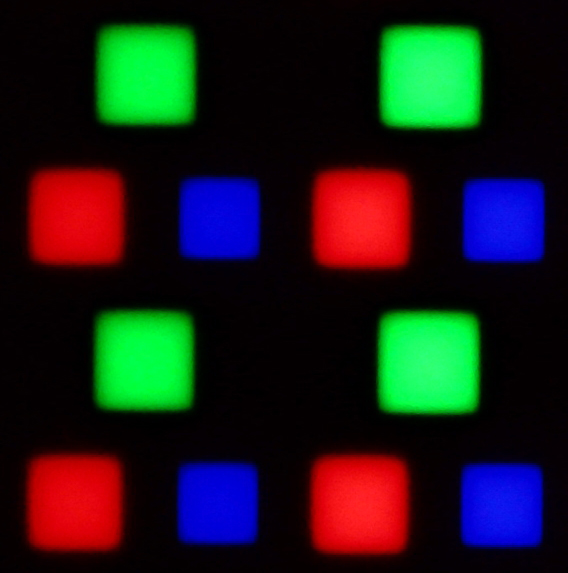
Panel uniformity and thermal imaging:


Philips The One (PUS8959 / PUS8919 / PUS8909 / PUS8949
Samsung OLED S85F (QD-OLED)
TV features
6.1/10
7.3/10
- HDMI inputs0 x HDMI 2.0, 0 x HDMI 2.1 48Gbps0 x HDMI 2.0, 4 x HDMI 2.1 48Gbps
- Other inputsToslink (Optical audio)
- OutputsToslink (Optical audio), eARC (HDMI), ARC (HDMI), Mini-Jack (Headphones)Toslink (Optical audio), eARC (HDMI), ARC (HDMI)
- Network InterfacesWi-Fi 2.4GHz, Wi-Fi 5GHz, Ethernet (LAN) 100MbpsWi-Fi 2.4GHz, Wi-Fi 5GHz, Ethernet (LAN) 100Mbps
- TV receptionDVB-T, DVB-T2, DVB-S, DVB-S2, DVB-CDVB-T, DVB-T2, DVB-S, DVB-S2, DVB-C
Classic features:
- Recording to USB (terrestrial TV)
- Recording programming
- Picture in Picture (PiP)
- RF remote control (no need to aim at the screen)
- Backlit remote control
- Teletext
- Audio only mode
- Bluetooth headphones support
- Simultaneous Bluetooth headphones & TV audio
Smart features:
- AirPlay
- Screen mirroring (Windows Miracast)
- Voice search
- Voice search in native language
- Ability to connect a keyboard and mouse



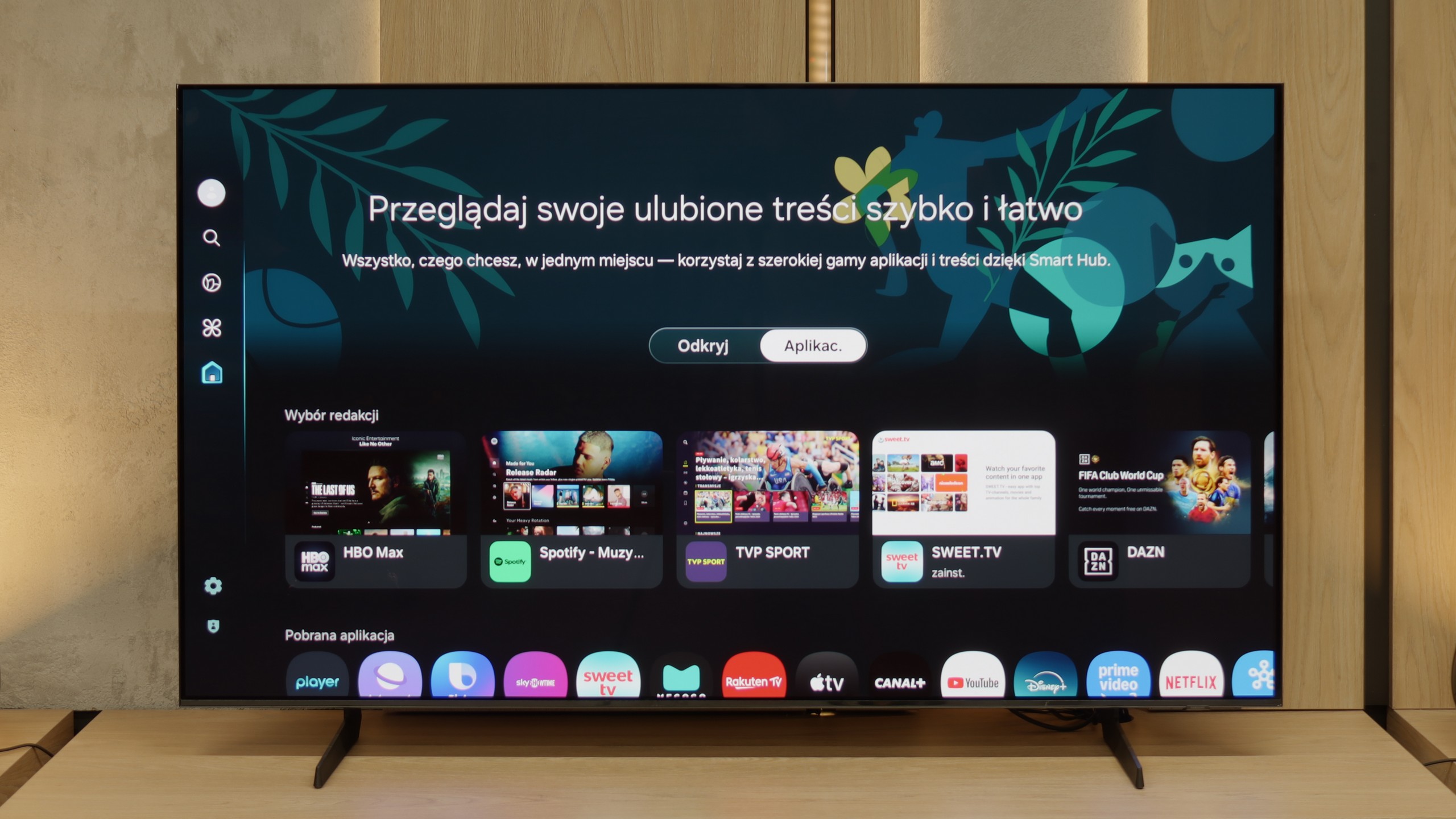
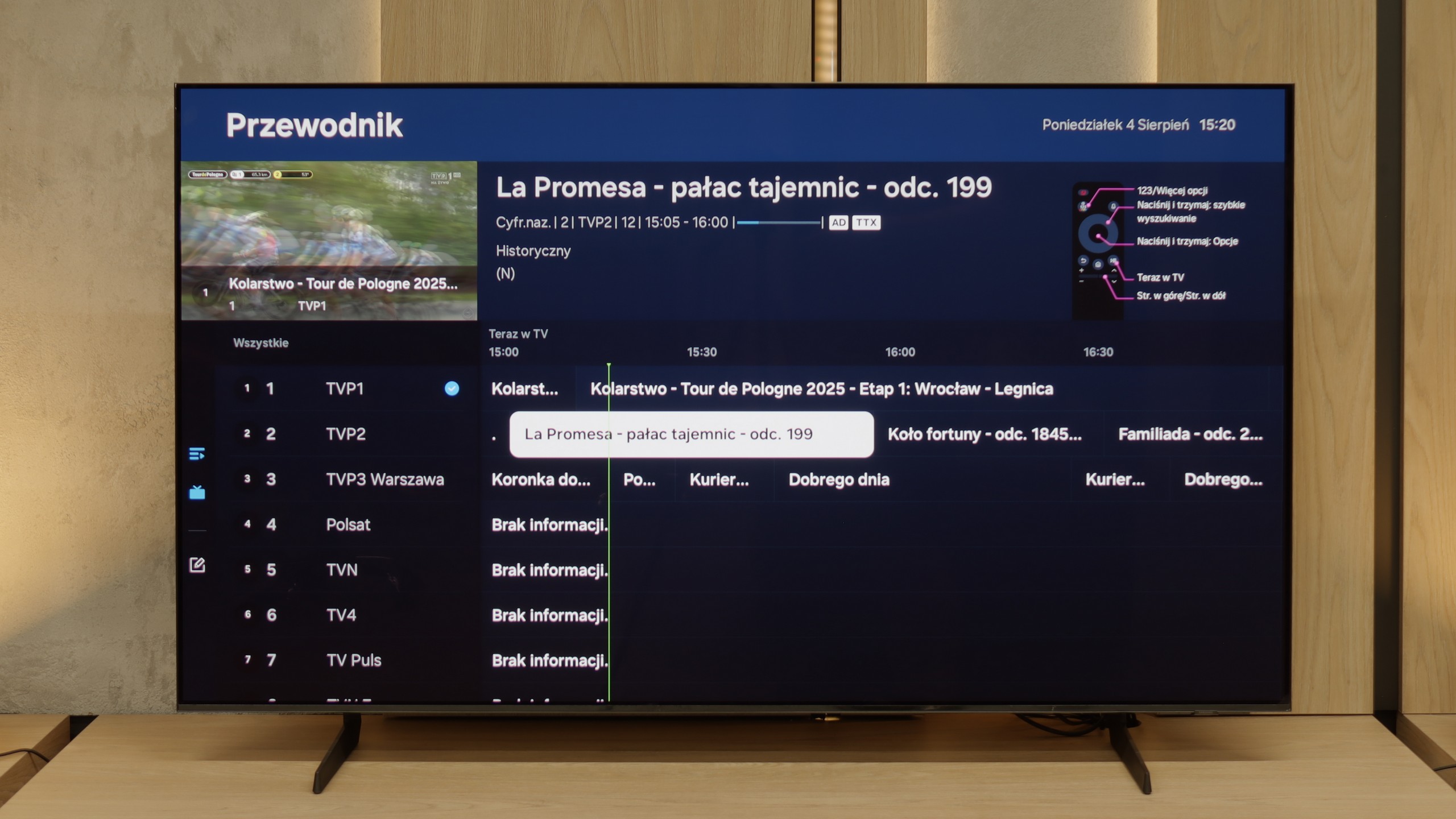
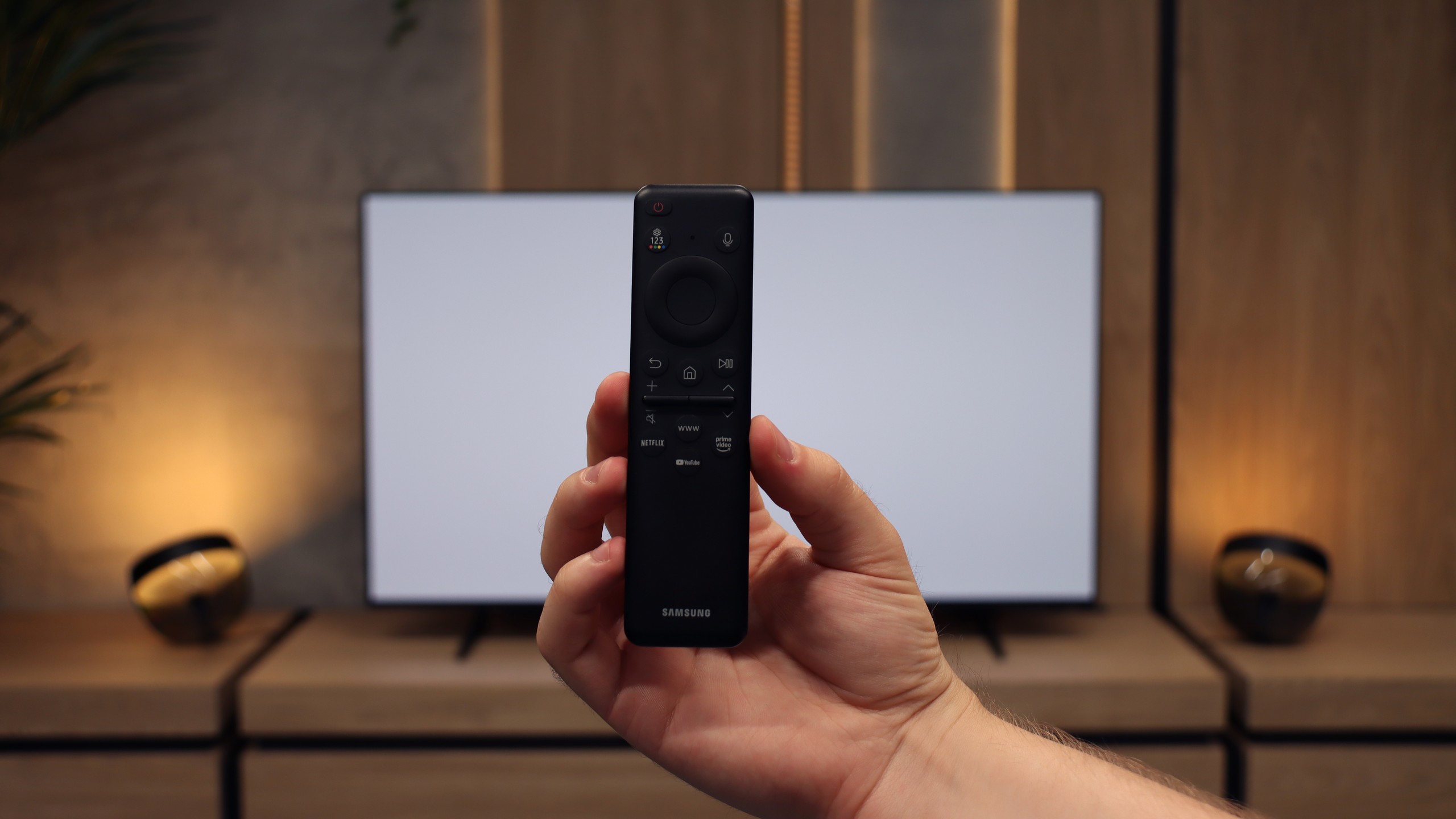
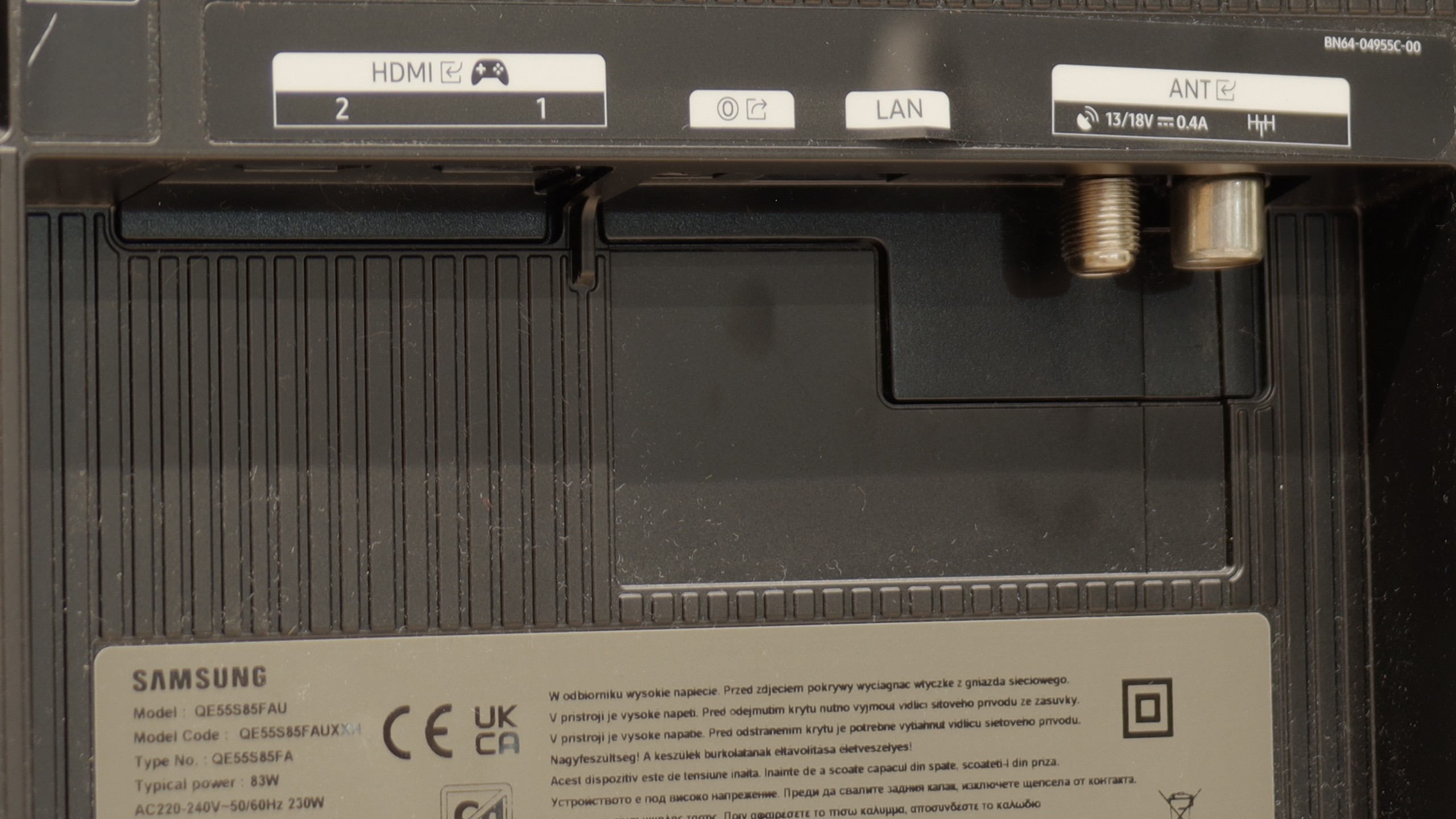
Philips PUS8959 is equipped with a three-sided Ambilight system – the flagship patent of this brand, which has delighted a dedicated group of fans for years. Ambilight relies on dynamic backlighting of the wall behind the TV, matching the content displayed on the screen, which significantly enhances the viewing experience, especially in dimly lit rooms. This effect is unique and adds a certain kind of "magic" to watching, causing many users to choose Philips specifically for this feature.
As for the operating system, Philips PUS8959 uses Titan OS – a system that is still in its early stages of development. Here, you can see growing pains, especially since Philips has moved away from Android in most of its models. Titan OS has a limited number of available apps. This is frustrating for those accustomed to a broader ecosystem like GoogleTV. Additionally, the TV does not have AirPlay functionality, which limits its compatibility with Apple devices and may be a drawback for users looking for a flexible way to stream content.
The user features of Philips PUS8959 are a mix of pros and cons. The remote control included with the TV is quite annoying – it requires direct aiming at the screen, which can be inconvenient. On the other hand, the voice function works without the need to aim, but it only supports English. On the plus side, the remote is backlit, making it easier to use in the dark. The TV does not have PiP (Picture-in-Picture) functionality or the ability to record programs, which is a significant drawback. However, the TV is equipped with Bluetooth, allowing connection to headphones or a keyboard, which can be useful – especially due to the limited number of available apps, which may encourage the use of the built-in web browser.
Features of the Classic S85F TV
The S85F was not really designed with fans of classic television in mind. We won’t find PiP functionality here (which is a bit surprising, because Samsung usually offers it) nor the ability to record programs to USB from the built-in tuners. Fortunately, the basics are present – teletext and a clear channel guide – so this is more than enough for regular, everyday viewing. The included remote, although simple at first glance and lacking a numeric keypad, allows for the control of multiple devices. This means that when connecting, for example, a Canal+ decoder, you don’t need to have two remotes on the table – the one from the television is sufficient.
SmartTV S85F: Tizen
The smart part is a completely different story. Tizen is one of the most advanced operating systems in televisions. It works efficiently, supports all popular internet functions – from screen mirroring, through AirPlay, to voice search. The strongest aspect of Tizen is its integration with the SmartThings app, which can act as a control center for the entire home. Of course, like any closed system, Tizen has its limitations – for instance, a smaller application library compared to GoogleTV. However, looking at the current list of available applications, it’s hard to pinpoint anything that might actually be lacking.
Playing files from USB
8.2/10
9.1/10
Supported photo formats:
Maximum photo resolution:

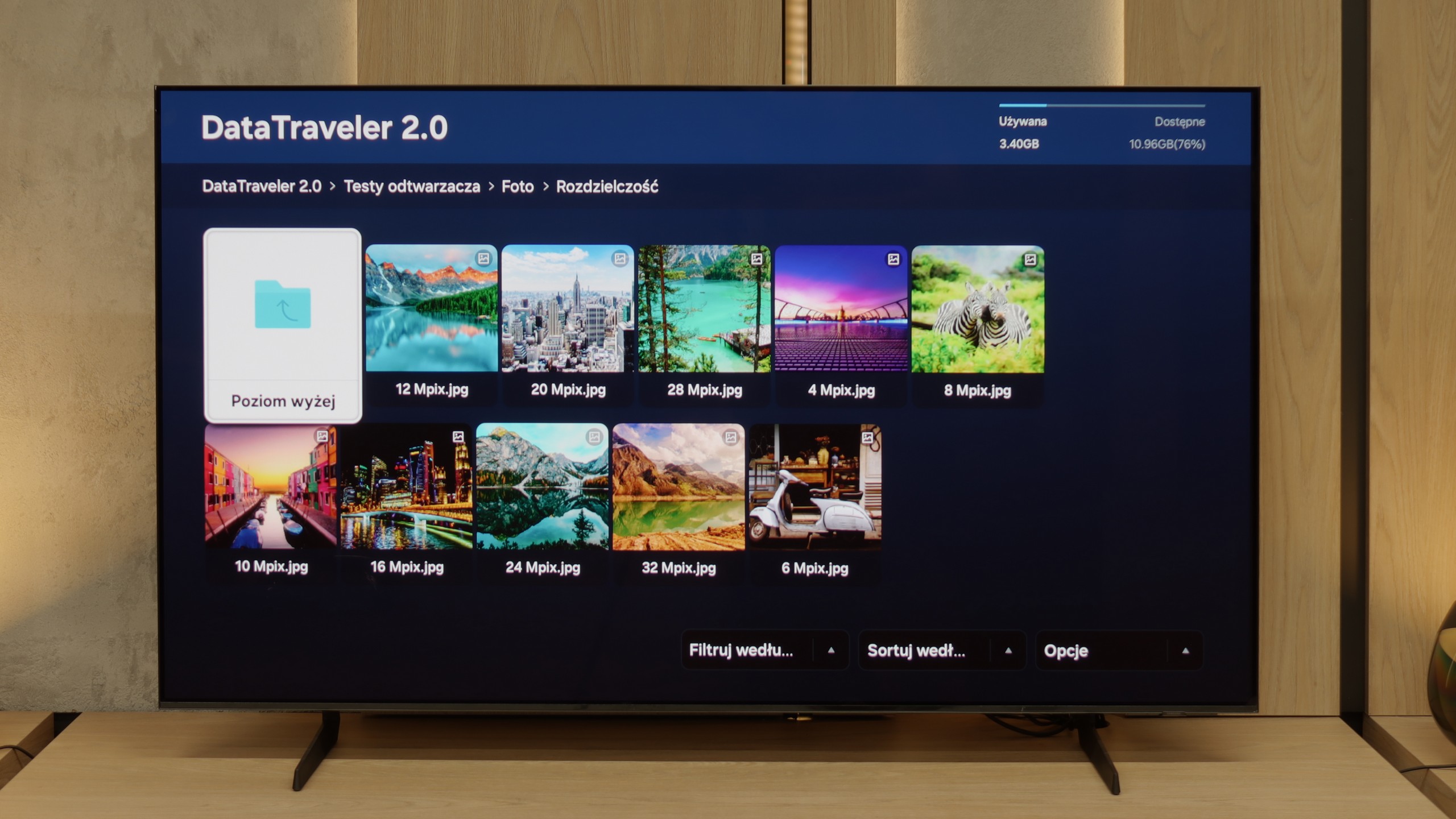
Although the Titan OS system on the Philips PUS8959 TV is still in its infancy, it deserves praise for supporting Polish subtitles embedded in movies, which is a significant convenience for users dealing with external files. If we want to play a movie from a connected USB device, the TV will do so without major issues, providing comfortable viewing without the need for additional subtitle configuration.
When it comes to photos, the TV should have no significant difficulties in playing them. It supports most popular formats, although it lacks support for less common standards such as HEIC used in Apple devices. This means that some photos, especially from newer Apple devices, may require prior conversion to a more standard format in order to be played on the Philips screen.
The built-in media player in the S85F performs excellently – almost everything you plug into a USB drive or disk will be played back without any issues. Minor gaps occur only with the support for some less common photo formats, but for the vast majority of you, this will be more than sufficient. So it can be confidently said that for home use, the built-in player is more than solid.
Apps
6.2/10
8.7/10














































Sound
6.4/10
7.2/10
- Maximum volume-80dB
- Dolby Digital Plus 7.1
- Dolby True HD 7.1
- Dolby Atmos in Dolby Digital Plus (JOC)
- Dolby Atmos in Dolby True HD
- DTS:X in DTS-HD MA
- DTS-HD Master Audio
The sound of the Philips PUS8959 unfortunately leaves a lot to be desired. Although the low frequencies can be heard in the playback, the bass is very weak, which results in an overall unsatisfactory sound quality. The TV plays average, especially when compared to more advanced audio systems available on the market.
Despite the average quality of the speakers, the TV supports all the essential audio codecs, which may please users using external home theater systems. Thanks to compatibility with various audio formats, the Philips PUS8959 can offer good audio experiences when connected to appropriate external speakers or a receiver, providing a fuller, more cinematic sound.
Built-in speakers with a power of 20 W on paper may not make a big impression, but in practice, the S85F can surprise. It sounds really pleasant, and at times, you can even catch a hint of bass, which is not a given in this class of speakers. The television does not support the DTS format, which unfortunately has become the standard for most manufacturers by 2025. A nice surprise, however, is the support for Dolby Atmos. Of course, talking about "spatial" sound in the case of two speakers placed at the bottom of the casing would be a bit of an exaggeration, but it's good that Samsung offers such a feature in this model at all.
Acoustic Measurements
No acoustic data
80dBC (Max)
75dBC


